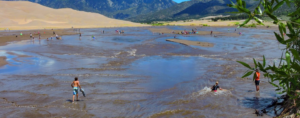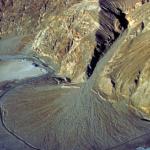Great Sand Dunes National Park and Reserves is located in South Colorado, USA. The nearest city to the park is Alamosa, which is at a distance of about 30 miles. The park is famous for its charming dunes in the shape of towering stars. It is famous for its huge sand dunes, and for the seasonal Medano Creek and beach created at the base of the dunes. The backcountry Medano Pass Primitive Road winds through a canyon toward the Sangre de Cristo mountains. Trails lead to forests, wetlands, and alpine lakes like Medano Lake, which is home to trout and tundra wildlife.

The great sand dunes of the park have risen to a height of 760 feet on the eastern edge of the San Luis Valley, and an adjacent national preserve in the Sangre de Cristo Range, in south-central Colorado, United States. The park was originally designated “Great Sand Dunes National Monument” on March 17, 1932, by United States President “Herbert Hoover”. The original boundaries of the park protected an area of about 35,528 acres (143.8 km2; 55.5 sq mi ). A boundary change and redesignation as a ‘national park and preserve’ was authorized on November 22, 2000, and then established on September 24, 2004. The park encompasses 107,342 acres (167.7 sq mi; 434.4 km2) while the preserve protects an additional 41,686 acres (65.1 sq mi; 168.7 km2) for a total of 149,028 acres (232.9 sq mi; 603.1 km2). The park is a popular tourist destination with 527,546 recreational visitors a year from 2019 onwards.
These are the tallest sand dunes in North America, which are scattered over an area of about 30 sq mi (78 km2) and are estimated to contain over 5 billion cubic meters (1.2 cubic miles) of sand. Sand came into existence as a result of sediments transported from the surrounding mountains. The transported sediments deposited here filled the valley over geologic time periods, and lakes within the valley receded. After the lakes receded, the exposed sand was blown by the predominant southwest winds toward the Sangre de Cristos. The transported sand eventually formed the dune field over an estimated tens of thousands of years. The mountain watershed, the dune field, the sand sheet, and the sabkha are the four primary components of the great sand dune system. Ecosystems within the mountain watershed include alpine tundra, subalpine forests, montane woodlands, and riparian zones.
to be continued…………coming soon


Leave a Reply